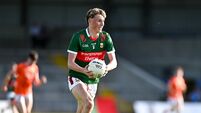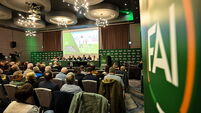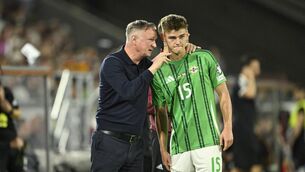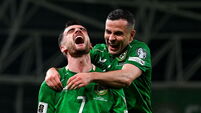Acute case of a hack’s diagnosis
No, I don’t feel I was overstepping the mark or being presumptuous. Haven’t I spent years offering pressbox diagnoses, after all?
Here’s the scenario. You’re watching a game and a player goes down, and from everywhere in the eyrie you share with other members of the fourth estate, the appraisals start coming in
“Concussion.”
“Ankle.”
“Groin.”
“Finger.”
“Contact lens.”
These widely disparate diagnoses, by the way, are usually centred on one individual case, a sportsperson who may be more than 100 yards away and hidden by a knot of medical staff and teammate, with only a helmet, or a pair of gloves, to indicate there is in fact a person hidden by all of those legs and bags.
This is a tradition with a long and venerable history. As a child, I remember one TV commentator whose fallback position was always that a player had “gone over on an ankle”, even when the blood was gushing from a participant’s forehead or an arm was dangling, useless, visible and broken, as the individual was walking, without a limp, from the field of play.
Nowadays the calls can be very specific in the pressbox, often functioning as an audible proof of that saying about a little learning being, etc, etc, though there are always one or two mischief-makers who take it upon themselves to muddy the waters.
“Gilmour’s groin.”
“Mouths.”
“Osteitis pubis.”
“Galloping dandruff.”
“Ah. Rotator cuff. Again.”
I’m sure many managers have been puzzled by the alacrity with which injury mishaps are brought up post-game, with a coach/bainisteoir/selector surrounded by a small crowd of anxious journalists looking for clarification as to why that player had to be substituted...
“Well, he felt his hamstring, we’re sending him for a scan tomorrow so we’ll have to see.”
If those managers ever wondered why there’s always one journalist who receives this bulletin with a broad smile, if not the actual words I told you so, hopefully this clears everything up.
Late to the party with this one: Aaron Hernandez of the New England Patriots in the NFL is in deep trouble with the law across the Atlantic, having been implicated in a series of crimes. Just this last week, Hernandez was convicted of the murder of one Odin Lloyd, who was going out with the sister of Hernandez’s fiancee.
When I saw that Rolling Stone were running a feature on the story, I hummed and hawed about checking it out, until I saw that one of those who wrote the feature was Paul Solotaroff, who wrote one of the greatest sports features I have ever read, The Power And The Glory, about a steroid-abusing bodybuilder called Steve Michalik (check it out — you can thank me later for opening your eyes about what weightlifters do with monkey brains).
In any event, the feature was engrossing, but one section caught my eye about Hernandez and his ability to get into mischief, or more accurately, his team’s capacity to keep him out of mischief.
“The NFL and its teams spend millions each year employing a web of former cops and ex-FBI agents to keep an eye on players and their posses,” the feature reads.
“For decades, the Patriots relied on a homegrown crew of retired state troopers to do surveillance. Whenever a player popped up where he didn’t belong — a strip joint in Southie or a weed spot in Brockton — Frank Mendes, the team security chief from 1990 to 2003 and a former state trooper himself, would get a call from his cop or statie friends, whether they were on payroll or not.
“‘I’d have known within a half-hour if Hernandez had gotten in trouble with police,’ he says, ‘and told (Bill) Belichick ( Patriots head coach) and he’d do whatever.’”
When the Patriots replaced Mendes with someone who’d handled security in Wembley Stadium, however, “tips from cops and troopers dried up”.
This passage provoked some different reactions here.
It’s surely only a matter of time before someone makes a movie about one of these cop-surveillance guys, probably with George Clooney in the lead, with some extra weight and a little more grey hair. I suppose you can’t be surprised if companies invest millions in individuals, they seek to safeguard that investment.
What kind of sport is it where the people who play it have to be the subject of a multi-million dollar surveillance industry which notifies their employers when they step out of line?
I don’t pretend to be naive. Sportspeople of all stripes can find trouble like a camel finds water in the desert, and I recall speaking to one legend of Irish sport who told me — suffice to say continuing with this anecdote would result in more redaction than a SiteServ email. But still.
It was very interesting during the week to hook up with Bill Gerard of Saracens rugby club for a leisurely waterside chat, and thanks again to UCC’s Economics Dept for facilitating same.
Gerard, who worked with Billy Beane of Moneyball fame before hooking up with Sarries, gave a glimpse of life at the sharp end of analytics with a professional sports franchise, and the full interview will be in these pages soon.
One interesting take-away, though, was his observation that it can sometimes be of benefit to a sports team if the analytics person isn’t wrapped up in the seven-day cycle, the pressurised turnaround from one game to the next.
Staying at a slight distance can offer an analyst the chance to take a broader view compared to the coaching staff who are trying to address issues which came up last weekend and which have to be resolved before next weekend.
Given how important analytics have become in recent years in all sports, it is a point well worth taking on board.












